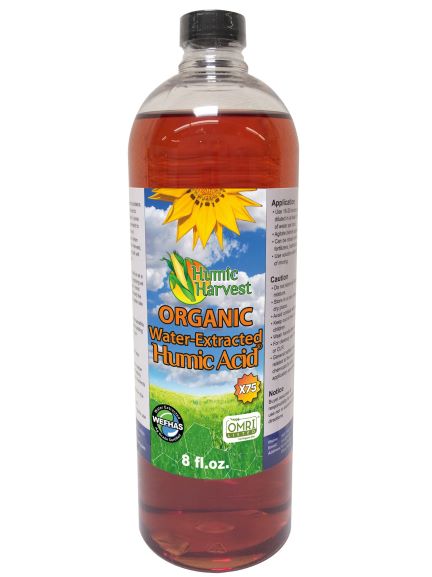Patented Water-Extraction
Humic/Fulvic acid and other humic substances, collectively referred to as humates, are the final stage of organic matter as it degrades to its smallest possible size. They are extremely complex molecules, formed naturally over time by soil microorganisms as they recycle the nutrients and organic matter present in decaying plant material. In healthy, pristine soils, humates are constantly formed by the life and death cycles of plant roots, microorganisms, and fungi in the soil. Modern agricultural practices have disrupted this cycle – in order to maintain good soil health, it is now necessary to add this critical component back into the soil, so that we can reap the benefits of working with instead of against nature.
Sustainable Agriculture Combats Climate Change
It has come to light through new research that land restoration could be very effective in playing a major part in the process of sequestering CO2, resulting in slowing down climate change. The product Organic Water Extracted Humic Acid® produced by the company Humic Harvest, could be a vital tool, in helping to turn around the effects caused by the degradation of soils from unsustainable agriculture along with other development projects. The negative impact of these issues (combined), have caused billions of tons of carbon to be released into the atmosphere. Resulting in having a negative effect on the overall climate.
The scientific community is conducting intense investigations on the importance of soil carbon—how it has been sucked from the earth and what can be done to reverse this process. They are hoping to find a way that can slow the increasingly rapid rise of carbon dioxide ending up in the atmosphere.
The Organic Water Extracted Humic Acid® could be the cure for global warming! Due to its ability to fix carbon in the soil, it could prove to be a very crucial tool in repairing our soils and ecology to a point where global warming could become a thing of the past. Researchers are expanding their knowledge about carbon sequestration in soils, by using Humic Acid in land restoration programs, trying to find safe and environmentally friendly ways of fighting against Global warming.
Working with products such as Organic Water Extracted Humic Acid®, can help us to stop the loss of carbon and critical microbes from the soil, that without these soil turns to mere dirt, a process that unfortunately is rampant around the globe. Humic Acid can heal soil, while improving crop quality and increasing yields.
With the use of this amazing product by Humic Harvest, it will help you to gain better results while using less fertilizer. With the Humic Harvest system, it will help you to prevent precious nutrient and fertilizer loss, which 80% can be lost due to runoff, nutrient lockup and volatilization. Humic Harvest creates conditions that offer protection to your investment and the environment simultaneously!
The world’s cultivated soils have lost a devastating 50% to 70% of their carbon stock, much of this oxidized when it was exposed to air becoming CO2, according to the renown director—Rattan Lal, of Ohio State University’s Carbon Management and Sequestration Center. Using regenerative agricultural practices such as those offered by Humic Harvest, can help essentially turn back the carbon clock, working at reducing the atmospheric CO2 while at the same time boosting soil productivity and increasing resilience to floods and drought. By bringing carbon back to the soils it will not only offset fossil fuels, but it will also help to feed the growing global population. If our soil is degraded we will not be able to feed the world’s population. Simply, we need healthy soil to grow our food supplies, without it we will not survive.
It has been stated by Scientists that more carbon resides in soil than in the atmosphere and all plant life combined; soil contains 2,500 billion tons of carbon, compared with 800 billion tons in the atmosphere and 560 billion tons in plant and animal life. We need to return carbon to where it belongs—the soil.
Change the Dynamics by Treating Soil Carbon as a Renewable Resource
A plant draws carbon out of the air to form carbon compounds through the process known as photosynthesis. Anything the plant does not need is exuded through its root system to feed soil organisms, whereby the carbon becomes humified, or rendered stable. The main component of soil organic matter is carbon, it helps to give the soil its structure, water-retention capacity, along with its fertility. It has been stated that there are some pools of carbon housed in soil aggregates that are so stable that they can last thousands of years. This contrasts with “active” soil carbon, located within topsoil which is in a continual flux between microbial hosts and the atmosphere.
Using a product such as Organic Water Extracted Humic Acid®, can help us in the process of treating the soil as a renewable resource. It can help fight against such things as soil erosion, which carries with it organic carbon, into waterways. The soil carbon becomes burned when the soil is exposed, it oxidizes causing the soil carbon to burn. With the aide of Humic Harvest, they can guide us to an alternate trajectory with the use of their products.
Scientists are still trying to learn how they can make the most of the soils CO2 sequestration capacity. Using an organic approach by adding beneficial microbes to stimulate the soil cycles that have been interrupted by the overuse of insecticides, herbicides and fertilizers. Programs that offer agroforestry, offer more diversity in species, and can maximize the storage of carbon than monocultures. Biochar is produced when plant matter, manure, or other organic material is heated in a zero-or low oxygen environment—for its ability to turn problem lands into productive sites while building soil carbon at the same time. Lands such as those that have been abandoned after soil degradation are excellent candidates for reforestation and replanting with the use of the biochar from the weeds now growing there.
When it comes to our croplands the how we grow them may be just as important as what we grow. Most wild plants are perennials, they have strong, deep root structures that help in the nourishing and stabilizing of the soil they grow on. However, most agricultural crops such as corn, wheat, soybean and rice are shallow-rooted annuals, that do not offer the same soil support as the perennials. The result is often poor-quality soil with low carbon content, even in well-managed cropland. Learning to develop food crops that have perennial traits could help to address this problem. You could also give Organic Water Extracted Humic Acid® a try and watch your garden grow while reducing the carbons in the atmosphere.
An important way of transporting carbon into soil is through root, or mycorrhizal, fungi, this helps to govern the give-and-take between plants and soil. It has been discovered through research that plants with mycorrhizal connections can transfer up to 15 percent more carbon to the soil than their non-mycorrhizal counterparts.
Mycorrhizal fungi are often marked by thread-like filaments called hyphae, that extend the reach of the plant, thus increasing access to nutrients and water. The hyphae have a sticky substance coating them called glomalin, which was discovered in 1996, which was found to be instrumental in soil structure as well as carbon storage. It has been advised by the U.S. Department of Agriculture that land managers should protect glomalin by minimizing chemical inputs and tillage, and making use of cover crops to keep living roots in the soil.
Using agricultural Humic/Fulvic acid and other humic substances, collectively referred to as humates, are the final stage of organic matter as it degrades to its smallest possible size. They are extremely complex molecules, formed naturally over time by soil microorganisms as they recycle the nutrients and organic matter present in decaying plant material. In healthy, pristine soils, humates are constantly formed by the life and death cycles of plant roots, microorganisms, and fungi in the soil. Modern agricultural practices have disrupted this cycle – in order to maintain good soil health, it is now necessary to add this critical component back into the soil, so that we can reap the benefits of working with instead of against nature.
Sustainable Agriculture Combats Climate Change
It has come to light through new research that land restoration could be very effective in playing a major part in the process of sequestering CO2, resulting in slowing down climate change. The product Organic Water Extracted Humic Acid® produced by the company Humic Harvest, could be a vital tool, in helping to turn around the effects caused by the degradation of soils from unsustainable agriculture along with other development projects. The negative impact of these issues (combined), have caused billions of tons of carbon to be released into the atmosphere. Resulting in having a negative effect on the overall climate.
The scientific community is conducting intense investigations on the importance of soil carbon—how it has been sucked from the earth and what can be done to reverse this process. They are hoping to find a way that can slow the increasingly rapid rise of carbon dioxide ending up in the atmosphere.
The Organic Water Extracted Humic Acid® could be the cure for global warming! Due to its ability to fix carbon in the soil, it could prove to be a very crucial tool in repairing our soils and ecology to a point where global warming could become a thing of the past. Researchers are expanding their knowledge about carbon sequestration in soils, by using Humic Acid in land restoration programs, trying to find safe and environmentally friendly ways of fighting against Global warming.
Working with products such as Organic Water Extracted Humic Acid®, can help us to stop the loss of carbon and critical microbes from the soil, that without these soil turns to mere dirt, a process that unfortunately is rampant around the globe. Humic Acid can heal soil, while improving crop quality and increasing yields.
With the use of this amazing product by Humic Harvest, it will help you to gain better results while using less fertilizer. With the Humic Harvest system, it will help you to prevent precious nutrient and fertilizer loss, which 80% can be lost due to runoff, nutrient lockup and volatilization. Humic Harvest creates conditions that offer protection to your investment and the environment simultaneously!
The world’s cultivated soils have lost a devastating 50% to 70% of their carbon stock, much of this oxidized when it was exposed to air becoming CO2, according to the renown director—Rattan Lal, of Ohio State University’s Carbon Management and Sequestration Center. Using regenerative agricultural practices such as those offered by Humic Harvest, can help essentially turn back the carbon clock, working at reducing the atmospheric CO2 while at the same time boosting soil productivity and increasing resilience to floods and drought. By bringing carbon back to the soils it will not only offset fossil fuels, but it will also help to feed the growing global population. If our soil is degraded we will not be able to feed the world’s population. Simply, we need healthy soil to grow our food supplies, without it we will not survive.
It has been stated by Scientists that more carbon resides in soil than in the atmosphere and all plant life combined; soil contains 2,500 billion tons of carbon, compared with 800 billion tons in the atmosphere and 560 billion tons in plant and animal life. We need to return carbon to where it belongs—the soil.
Change the Dynamics by Treating Soil Carbon as a Renewable Resource
A plant draws carbon out of the air to form carbon compounds through the process known as photosynthesis. Anything the plant does not need is exuded through its root system to feed soil organisms, whereby the carbon becomes humified, or rendered stable. The main component of soil organic matter is carbon, it helps to give the soil its structure, water-retention capacity, along with its fertility. It has been stated that there are some pools of carbon housed in soil aggregates that are so stable that they can last thousands of years. This contrasts with “active” soil carbon, located within topsoil which is in a continual flux between microbial hosts and the atmosphere.
Using a product such as Organic Water Extracted Humic Acid®, can help us in the process of treating the soil as a renewable resource. It can help fight against such things as soil erosion, which carries with it organic carbon, into waterways. The soil carbon becomes burned when the soil is exposed, it oxidizes causing the soil carbon to burn. With the aide of Humic Harvest, they can guide us to an alternate trajectory with the use of their products.
Scientists are still trying to learn how they can make the most of the soils CO2 sequestration capacity. Using an organic approach by adding beneficial microbes to stimulate the soil cycles that have been interrupted by the overuse of insecticides, herbicides and fertilizers. Programs that offer agroforestry, offer more diversity in species, and can maximize the storage of carbon than monocultures. Biochar is produced when plant matter, manure, or other organic material is heated in a zero-or low oxygen environment—for its ability to turn problem lands into productive sites while building soil carbon at the same time. Lands such as those that have been abandoned after soil degradation are excellent candidates for reforestation and replanting with the use of the biochar from the weeds now growing there.
When it comes to our croplands the how we grow them may be just as important as what we grow. Most wild plants are perennials, they have strong, deep root structures that help in the nourishing and stabilizing of the soil they grow on. However, most agricultural crops such as corn, wheat, soybean and rice are shallow-rooted annuals, that do not offer the same soil support as the perennials. The result is often poor-quality soil with low carbon content, even in well-managed cropland. Learning to develop food crops that have perennial traits could help to address this problem. You could also give Organic Water Extracted Humic Acid® a try and watch your garden grow while reducing the carbons in the atmosphere.
An important way of transporting carbon into soil is through root, or mycorrhizal, fungi, this helps to govern the give-and-take between plants and soil. It has been discovered through research that plants with mycorrhizal connections can transfer up to 15 percent more carbon to the soil than their non-mycorrhizal counterparts.
Mycorrhizal fungi are often marked by thread-like filaments called hyphae, that extend the reach of the plant, thus increasing access to nutrients and water. The hyphae have a sticky substance coating them called glomalin, which was discovered in 1996, which was found to be instrumental in soil structure as well as carbon storage. It has been advised by the U.S. Department of Agriculture that land managers should protect glomalin by minimizing chemical inputs and tillage, and making use of cover crops to keep living roots in the soil.
Using agricultural Humic acid such as Organic Water Extracted Humic Acid® is the best input for organic farming and sustainable agriculture. Many producers around the world have yet to experience this wonder, and utilize this innovative product. It is surprising that this organic substance has remained so unstated and poorly utilized. Making use of such a product will help to effectively prevent the loss of nutrients and protect the environment at the same time.
such as Organic Water Extracted Humic Acid® is the best input for organic farming and sustainable agriculture. Many producers around the world have yet to experience this wonder, and utilize this innovative product. It is surprising that this organic substance has remained so unstated and poorly utilized. Making use of such a product will help to effectively prevent the loss of nutrients and protect the environment at the same time.









